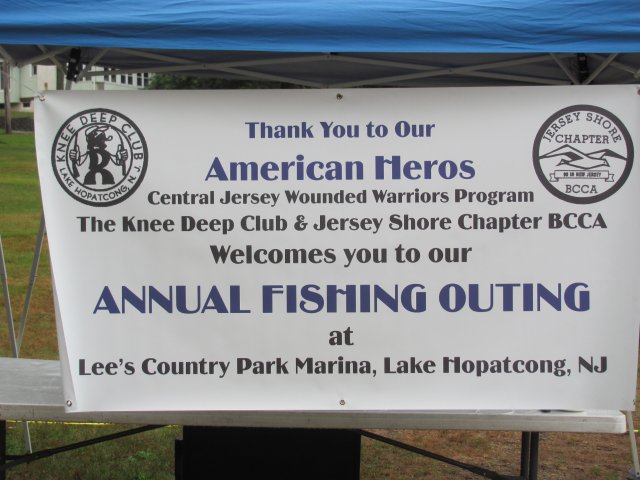
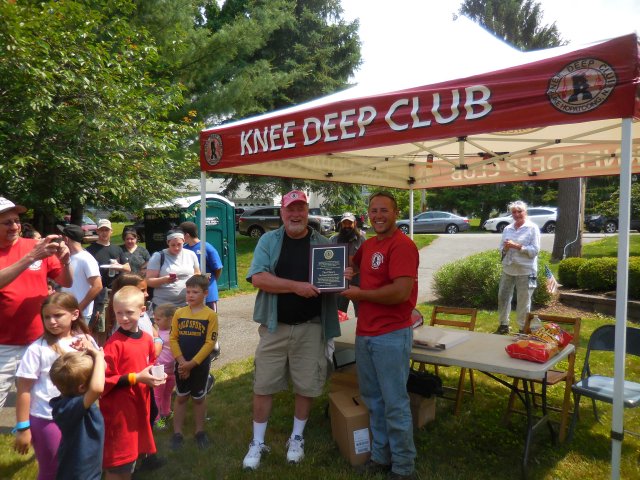
Director Emeritus Award Presented to Tim Clancy for his years of service 6/11/16.
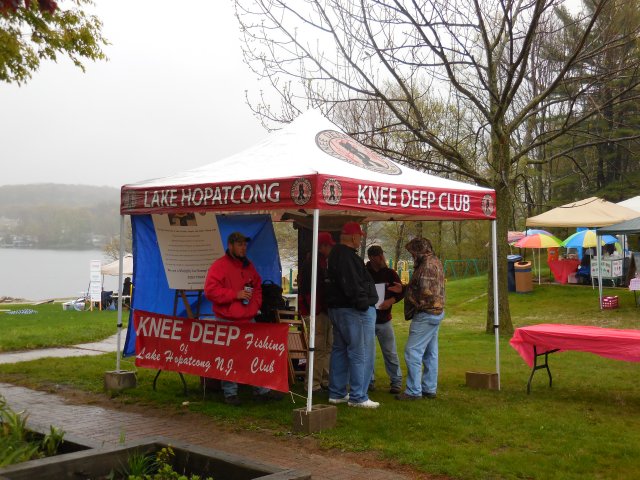
Photos from the LHF Block Party May 2016.
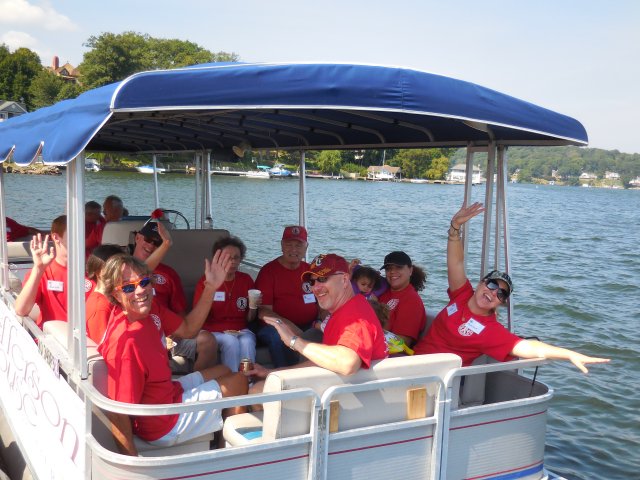
Some photos from the American Heroes on the Water Fishing Outing 8/28/15

Photos from the LHF Block Party May 2015. New canopy and Eddie's presentation.
LAKE CLEAN-UP PICTURES 2013 taken by Jim Salerno
The 60 inch (five foot) drawdown is scheduled every five years and begins on or after September 22. During the 60 inch drawdown from December through February, when ice conditions permit, the lake is allowed to rise but not higher than the 26 inches below the spillway elevation.

Lou Marcucci was honored for his years of service with the club on 3/3/12, thanks Lou!
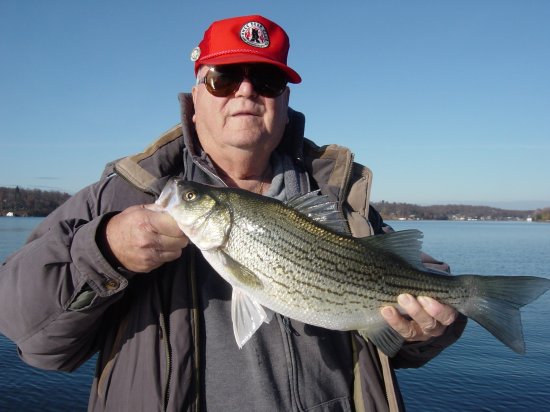
Long time member and trustee, Domenico Bizzari passed away 10/26/09. He will be missed.
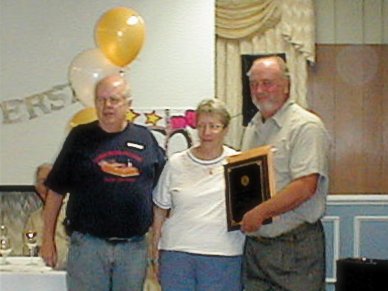
In 2009, Bill Wiedeman, at left, was presented a KDC Lifetime Achievement Award
for his many years of service to the club.
Lake Hopatcong benefited from dedicated sportsmen
Sunday, February 10, 2008
BY JOE KASPER
TIMES OUTDOORS COLUMNIST
Sportsmen are the original conservationists and have been paying for wildlife and environmental conservation for better than 100 years. Giving something back to the outdoors and the wildlife comes naturally to most dedicated sportsmen. Just such a case is the relation ship between Lake Hopatcong and the Knee Deep Club.
The 2,685-acre lake, the state's largest natural lake, is a spring-fed body of water that was formed by glaciers in pre-historic times. It was a favorite fishing, hunting and trapping grounds for the Le nape tribe. European colonists began settling in the area in the 1700s, and several dams were built to raise its water levels. Starting in the 1750s, a dam was built to power a forge by what is now Hopatcong State Park. After the War of 1812, the Morris Canal was constructed to facilitate the iron ore mining in the area, and as a trade route to north Jersey's growing cities. Hopatcong, which is located 900-feet above sea level, was the largest source of water for the canal. Eventually, the railroad took over the transportation of ore, and by September of 1882, passenger service to the lake started an expanding tourism industry that lasted well into the 1930s. An amusement park, hotels, restaurants, yacht clubs, fishing, even a winter ice industry flourished until World War II. After WWII, the lake continued to serve as a summer vacation spot for the middle class and with the construction of Route 80 in the mid 1970s, the lake began the transition to a residential community.
The Knee Deep Club came into being in August of 1946, when a group of sportsmen met at what was then Spencer's Sport Center, which is now the site of the State Police Station in Great Cove. From its onset, the club lobbied state and federal fish and game departments for fish for stocking in the lake. It also began its monthly meetings, which still take place. The club, since that humble beginning, has worked tirelessly to maintain and improve the lake, its water quality, access, fisheries and ecosystem.
Stocking Efforts:
During the first years, the club concentrated on the stocking of trout in the lake. In conjunction with the Division of Fish and Game, 2,500 trout were stocked in 1953, followed by 7,500 trout in 1954 and 7,000 trout in 1955.
A few years back, the Division of Fish and Wildlife, which annually stocked better than 10,000 trout in the lake, decided to take Hopatcong and several other large lakes off the stocking list. It was through the well-organized efforts of the Knee Deep Club that the Division changed its mind and took the lake off the hit list, while other large lakes are no longer stocked.
The club was also instrumental in getting the walleye population started in the lake. In 1953, the club lobbied the Division to begin walleye stocking, which the Division did for several years but discontinued in 1955, citing poor re turns. Natural reproduction began with those first fish and proved the fish could thrive in the lake. The club stocked walleye on a limited basis in 1964 and 1968 and then on a regular basis from 1979-1985. The state finally agreed that the stocking of walleyes was a worthwhile endeavor, and in 1994, the state began once again stocking the fish. This led to a cooperative effort between the club and the Division, which is still going on today.
Knee Deep was also responsible for getting the successful hybrid striper program up and running. The club began stocking hybrid stripers in 1985 with 1,000 12- to 15-inch fish. Over the next 10 years, with financial help from the Fish America Foundation, it stocked close to 60,000 hybrids. Once again making believers out of the Division of Fish and Wildlife, which in 1993, started annual stockings of up to 20,000 fish. The hybrid fishery is now considered the best in the state.
The club was also stocked channel catfish, beginning in 1961. Here, too, the club proved to the state that the lake could support a healthy channel cat population, and the state now annually stocks 4,000 fish. The lake also holds the state record for channel cats, with a 33-pound, 3-ounce fish caught by Howard Hudson in 1978. The club has also stocked largemouth, smallmouth and spotted bass in the lake.
Water Quality:
The great fisheries that the club helped start and maintain would not have been as successful without good water quality. However, this was not always the case. In fact, in the mid 1970s, the lake was in severe decline with problems with algae, weeds and declining water quality due to an influx of nutrients, phosphorus and nitrogen from storm sewers, run off from lawns and septic systems. The club worked to educate the people in the communities that surrounded the lake about the problems and their causes. In addition, the club worked with state and local municipalities to solve these problems. As a result, the lake has some of the best water quality in the state, and its fisheries and ecosystem continue to improve each year.
Youth Programs:
The club has always seen the value of keeping the younger generation involved in fishing, and early on, it instituted a junior awards program and sponsored a Junior Derby that is held on the lake in June. Originally the derby was limited to club members. However, in 1961, the club opened up the derby to the public, and today it is one of the most popular programs for the club.
Handicap Outing:
Knee Deep also hosts a Handicap Outing which it began in 1975 to help the Easter Seals Foundation and is now funded through the William H. and Sadie R. Cutter Trust Fund and the Cheesebo rough-Summit Home for Children. Each year the club invites dozens of children from various group homes for the disabled and sup plies fishing tackle, trophies and t- shirts, along with individual assistance to the kids.
Bill Clark, long time KDC member, trustee, and advocate passed away 12/23/06, he will be missed.
The Knee Deep Club started its 60th year Friday with awards for 2005's best catches, a showing of a DVD of fishing the state's largest lake in 1949 and the announcement of plans to stock 4,150 trout this spring, adding to the 9,200 that will be stocked by the Division of Fish and Wildlife.
Division plans to stop state trout stocking at the lake this year were dropped, thanks to the KDC, which carried on the fight of its founders who started the club in 1946 and had to catch trout in streams and stock them to prove trout could live there.
The club, without any early help from the state, also had to fight to stock hybrid bass, walleyes, muskellunge, channel catfish and walleyes in the lake. No wonder the group got its name in 1946 from a wife who said the guys always were "knee deep" in working for the lake.
Today's club led by an active slate of officers, trustees and directors, holds fishing programs for handicapped and kids, improves habitat and fisheries, holds contests and supports conservation. Meetings are held on the second Friday from March through October at the Hopatcong Civic Center. More info is on the KDC website: kneedeepclub.org/.
The nearly $20,000 worth of trout to be float stocked around the lake from Dow's dock on Nolan's Point April 2 and May 13 will be mostly browns, some rainbows, no brookies. About 3,600 will range from 11-14 inches, 100 15- 6-inchers, 125 18-20 inches long and some bigger ones. Everyone is invited to the 10 a.m. stocking and to enjoy trout fishing after the season opens on April 8.
The color DVD of 1949 fishing was converted from a 16 mm. film that shows when pickerel, bullheads and largemouths were the lake's primary species, all caught with fly rods and baitcasting rods. We didn't have spinning tackle back then, when fly rods with worms were the most popular way to fish streams for trout.
Tim Clancy narrated the silent film, pointing out landmarks, shorelines without homes and docks and a lake surface flat because high-powered boats weren't zooming around. Laura presented checks and plaques last weekend at the club's annual Leo August breakfast at the Windlass. Leo was a club president who willed funds for the breakfast.
The club gave a check for $500 to Carl Platvoet of Franklin for a 10-pound, 5-ounce, walleye, $200 to Lenny Stelmack of Byram for his 10-pound, 1-ounce, hybrid bass, and $100 to Brad Garie of Rockaway for a four-pound smallmouth caught through the ice last March. Three club members who fished through the risky ice last Sunday came up with a 41-inch musky and three channel cats from 9-11 pounds.
KDC YEARLONG CONTEST HISTORY AT-A-GLANCE 1998-2003
SENIOR and JUNIOR
KDC Member and Supporter Roger Steiger passed away 1/10/2004
KDC Trustee Mike Rybak passed away on Nov. 1, 2003
They will be missed by all.

Click here for more details and origins of the map.
BACKGROUND ON LAKE HOPATCONG
(excerpt from Lake Hopatcong Commssion's progress report after first 18 months in operation)
History of the Area. Lake Hopatcong was originally two adjacent lakes that were the headwaters of the Musconetcong River. A dam was constructed in 1750 to provide power for a local iron forge, and the water level increased by some 5 feet and combined the two lakes into one larger lake. The lake as it is known today was created through the construction of another dam in 1827 by the Morris Canal and Banking Company as part of its efforts to build the Morris Canal, which by the 1830s was a major means for transporting coal, iron, and zinc across New Jersey. As railroads developed in the area, the slower canal traffic became obsolete, and the canal was abandoned. The lake was acquired by the State of New Jersey from the Morris Canal and Banking Company in 1922. Today, Lake Hopatcong is part of Hopatcong State Park, which is administered by the Division of Parks and Forestry within the New Jersey Department of Environmental Protection (NJDEP).
Characteristics of the Lake. The 9.5-mile-long Lake Hopatcong is the largest lake in the State and is located in the northwest part of New Jersey on the borders of Sussex and Morris Counties. Four municipalities surround the Lake-within Morris County are Roxbury Township, Mt. Arlington Borough, and Jefferson Township, and within Sussex County is Hopatcong Borough.
Lake Hopatcong is a major year-round recreational center in New Jersey for boating, sailing, and swimming and is considered one of the best freshwater fisheries on the East Coast. During the winter, ice fishing, ice boating, and snowmobiling are popular activities. Hopatcong State Park is one of the busiest parks in the State system, hosting over 159,000 this past summer. The Lake's 14.7 billion gallons of water are also considered an emergency source of drinking water for the State of New Jersey.
The 2,700-acre Lake has over 38 miles of shoreline and a watershed population of over 65,000 people. The Lake Hopatcong watershed (the surrounding area that contributes to the water quality and quantity) is relatively small, on the order of 13,500 acres. Much of the surrounding watershed area is undeveloped forest, and growing residential development surrounds the Lake. Although there is a growing commercial base in the area, little major industry is present at this time that may adversely affect the Lake.
Lake Hopatcong has no major tributaries; rather, the inflow to the Lake is contributed by a number of brooks and streams from the mountain area surrounding the Lake. On the other hand, the Lake has a major point of discharge through a dam at Hopatcong State Park, releasing an average 7.5 million gallons a day (MGD) downstream, which provides the headwaters for the Musconetcong River, a tributary to the Delaware River. A downstream lake, Lake Musconetcong, is dependent on Lake Hopatcong's discharge.
Environmental Problems in the Lake. Similar to other urbanized lakes, Lake Hopatcong is affected by advanced cultural eutrophication. The word "eutrophic" is a Greek term for "well-nourished," which describes a process of physical, chemical, and biological changes to a freshwater body caused by nutrient, organic matter, and siltation deposition that results in accelerated aging. As a lake ages, it begins to fill in from increased vegetation and sedimentation, becoming a swamp and, eventually, a forest. If the process is accelerated by man-made influences, as is the case at Lake Hopatcong, it is termed cultural eutrophication. In short, Lake Hopatcong is aging faster than it should, and overgrowth of algae and aquatic vegetation is an ongoing problem.
One characteristic of Lake Hopatcong that is particularly telling about its eutrophic condition relates to its hydraulic residence time, which is the average time required to renew a lake's volume. More simply, this represents a measure of the "flushability" of a body of water for moving nutrients through and out of the water column. A short hydraulic retention time would indicate a high volume of water flow, resulting in less production of biological forms such as algae because the cells are flushed out faster than they can grow and accumulate. On the other hand, a longer hydraulic residence time suggests that nutrients can accumulate in the water body, and biological forms have more time to grow and multiply. Lake Hopatcong demonstrates a long hydraulic residence time, on the order of about 623 days, or 1.7 years, which means that it presents an ideal environment for harboring nutrients and biomass, as demonstrated by the excess algal and aquatic vegetation overgrowth.